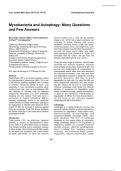Mycobacteria and Autophagy Liang et al.
Curr. Issues Mol. Biol. (2017) 21: 63-72. horizonpress.com/cimb
Mycobacteria and Autophagy: Many Questions
and Few Answers
Min Liang1#, Zeshan Habib1#, Kaori Sakamoto2, immune system acts to "wall off" the bacteria
Xi Chen1,3* and Gang Cao1* (Saiga et al., 2011). Some latent infections can
progress to active disease with severe
1State-key Laboratory of Agricultural symptoms, including chronic cough with blood-
Microbiology, Huazhong Agricultural University, containing sputum, fever, and weight loss. Over
Wuhan, 430070 China 100 million people have died from tuberculosis in
2Department of Pathology, College of Veterinary the past 100 years, and 9 million new cases
Medicine, University of Georgia, Athens, GA, were reported in 2014 (Zumla et al., 2015). It is
30602 USA estimated that 35 million will die from TB
3College of Informatics, Huazhong Agricultural between 2000-2020 (Zumla et al., 2015).
University, Wuhan, 430070 China
*Corresponding authors: chenxi_419@163.com; During the early stage of infection, macrophages
gcao@mail.hzau.edu.cn dominate the immune response, because
#These authors contributed equally to this work. macrophages are the major reservoir of Mtb. The
survival and multiplication of mycobacteria in
DOI: http://dx.doi.org/10.21775/cimb.021.063 macrophages and/or other host cells determine
the outcomes of infection. Host cells have their
Abstract own degradation systems to antagonize invading
Tuberculosis (TB) is an ancient disease caused bacteria. Meanwhile, Mtb tries to avoid
by Mycobacterium tuberculosis (Mtb). TB is one degradation by host cells. It is clear that Mtb can
of the world's deadliest diseases, with one-third block phagosomal maturation and may escape
of infected individuals falling ill each year into the cytosol for survival in macrophages.
especially in many developing countries. Upon However, autophagy could target the cytosolic
invading host cells, such as macrophages, Mtb bacteria to lysosomes for degradation under
can replicate in infected cells by arresting certain conditions through unclear mechanisms.
phagosome maturation and then potentially In light of the mysterious mechanism(s) of
escaping into the cytosol. Host cells have a degradation of Mtb by the host during infection,
mechanism to control intracellular Mtb by we will focus on the cross-talk between
inducing autophagy, which is an elaborate autophagy and Mtb in this review.
cellular process to target intracellular pathogens
for degradation in infected cells. However, some Autophagy
factors of Mtb are involved in defense against Autophagy is a highly-conserved process that
killing by autophagy. Thus, this review highlights serves to deliver proteins or whole organelles to
the recent advances in the interactions between lysosomes for degradation. Three major forms,
autophagy and Mtb. m a c r o a u t o p h a g y, m i c r o a u t o p h a g y, a n d
chaperone-mediated autophagy (CMA), have
Introduction been identified. The form of autophagy
Tuberculosis (TB), an infectious bacterial discussed in this review refers to macroauto-
disease, is caused by Mycobacterium tuber- phagy. Autophagy results in the engulfment of
culosis (Mtb). It is transmitted mainly via droplets cytoplasmic proteins by a double membrane
from people showing active respiratory disease bounded structure, called the autophagosome,
to other people. Most infections with Mtb usually which is initiated from membrane sources,
do not cause any symptoms; this is also known including: the endosome/Golgi system,
as latent tuberculosis, in which the person's endoplasmic reticulum-mitochondrial contact
!63
, Mycobacteria and Autophagy Liang et al.
sites (Chan and Tang, 2013; Hamasaki et al., Through autophagy, the host cell combats
2013), the plasma membrane (Ravikumar et al., intracellular pathogens by fusing autosomes with
2010), and phospholipid precursors (Dupont et lysosomes to sustain homeostasis. Moreover, it
al., 2014). Autophagy-related genes (ATG) have is implicated that autophagy can modulate MHC
been reported to be accountable for its Class I-mediated antigen cross-presentation
execution, of which the ubiquitin-like conjugates, (Oliveira and van Hall, 2015). When autophagy
Atg12-Atg5 and LC3-phosphatidylethanolamine, is impaired, it may contribute to the pathogen-
are required for autophagosome formation. esis of some pulmonary diseases (Ryter and
There are several regulators/stimulators of cell Choi, 2015).
autophagy, including mammalian target of
rapamycin (mTOR), presence of microbes Restriction of intracellular Mtb replication by
(Tattoli et al., 2012), the TAB2/3-TAK1-IKK autophagy
signaling axis (Criollo et al., 2011), events Mtb survives in infected host cells by blocking
downstream of pattern recognition receptors phagosome maturation or escaping from
(PRR) and immune cytokine activation (Lee et phagosomes to the cytosol; this is attributed to
al., 2007), transcription factor EB (Settembre et the failure of bacilli to undergo delivery into
al., 2011), and proteolytic systems via FOXO3a lysosomes (Figure 1). The purpose of this review
(Masiero et al., 2009). Meanwhile, autophagy is not to provide a comprehensive summary of
activation is under the control of different phagosomal maturation arrest strategies used by
promoters/inducers, such as the transcription Mtb, as there are already excellent reviews
factor, TFE3 (Martina et al., 2014), and drugs or covering this subject (Simeone et al., 2015;
nutritional supplements (Levine et al., 2015). Welin and Lerm, 2012). Instead, this article will
Figure 1. Interaction of Mtb with autophagy in host cells.
!64




